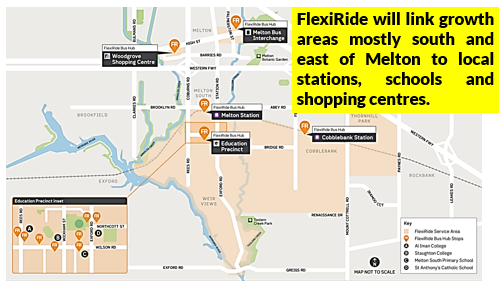For a while not much happened with buses in Melbourne. Now things are hotting up.
But not in a way that you might expect. Rather than merely seeing reform and strengthening of the fixed route network, we are now witnessing the emergence of dual competing and overlapping bus systems in some of our suburbs.
Planned without reference to the other, each has different information systems, mobile apps and even public holiday service arrangements. Each has backing from within differing sections of the Victorian Department of Transport.
Recent and current DoT management has been very attracted to flexible route buses. Recent examples include the (now departed) Megan Bourke-O'Neil and current Departmental Secretary Paul Younis who last week before PAEC credited FlexiRide Rowville with a 2000% (!) patronage uplift compared to the previously (poorly used) Telebus. DoT marketers have been similarly effusive, describing FlexiRide as 'Passenger Power'.
Planners several rungs below tend to be more skeptical, being concerned about the poor track record and high opportunity costs of flexible routes. They stress the unrealised potential for cost-effective reform to existing fixed routes which have too often sat unreviewed for years. This perspective has not necessarily enjoyed much sway in top DoT ranks nor amongst some previous ministers. However a new minister and Victoria's Bus Plan have signalled revived interest in network reform. Reform capability in the Department is also being boosted with the recent appointment of George Konstantopoulos to the new role of Director of Bus Reform and a team under him.
'Simple connected journeys' notwithstanding, these different tendencies within the Department have not necessarily been set to work in concert to produce the best possible network from available resources. This is despite the general funding scarcity for services that ought to make duplication something to be avoided. The result is whole suburbs like Rowville and Chirnside Park got two part-time half networks rather than one full-time network.
This isn't the first time we've had what could be described as rivalries between different types of public transport. A century ago the railways and tramways competed with one another rather than coordinating against private motoring. We still see relics of this today, with many tramlines finishing a half mile from stations and interchange not as good as it could be.
Today public transport typically makes operating losses rather than profits. And we have a Department of Transport supposed to provide coordination between and within modes. But as you'll read later this doesn't always occur, with the emergence of FlexiRide making the network more rather than less fragmented, with Melton South being the latest example.
FlexiRide coming to Melton South
Melton South, I hear you ask? It's getting a new FlexiRide bus. Announced last Friday it will provide much needed coverage to a substantial growth area that hasn't had it. Areas to gain include Thornhill Park to the east and a long finger south along Exford Rd including Weir Views. It will be an early Christmas present with service starting in less than a month. A map, from the PTV FlexiRide page, is below.
Differences with other FlexiRides
How is Melton South's service different to the already established FlexiRides in Melbourne's outer east? There's three main points:
Similarities to other FlexiRides
Again I can think of three main points.
1. It involves four buses and associated drivers, according to the initial media release. This makes it a similar scale to the Rowville/Lysterfield FlexiRide. Four buses and drivers is a not insubstantial resource commitment for new buses as the typical outer suburban growth area fixed route may require two. More on that later.
2. FlexiRide will operate over an existing fixed route bus network. Mostly Route 454 but a part of 457 as well. This overlap potentially reduces passenger per service hour productivity on both services. Partly offsetting this is that there will still be significant unique coverage, especially south along Exford Rd and around Thornhill Park.
3. Information is fragmented. The Department of Transport regard FlexiRide and regular bus services as different 'silos' even though they serve significant common areas and passengers will sometimes use either. This infects most of their attempts at information provision. As an example, their FlexiRide Melton South Map omits regular route buses. Hence I had to annotate their map with fixed routes to get a picture of the total service offering (below).
Attention to webpage coding is lacking with the FlexiRide page appearing current at first glance but underlying source code still having Telebus text. This causes out of date text to appear if people try to share the page on web forums or Facebook. That's critical as we know that online sharing is a vital way that awareness of new services is spread.
I've already discussed bus network maps omitting FlexiRide and FlexiRide maps ignoring the fixed bus routes. In a flashback to what was done with old-style regional town buses, FlexiRide services doesn't even have route numbers. That makes it harder to find details of them on the PTV website. Oddly other flexible routes are numbered (like 474 and 490).
There's also the disparate apps involved. For Android the PTV app takes up about 46 MB vs 132 MB for FlexiRide. People are more likely to delete big apps if their phone memory is near full. Not having the app may introduce a small barrier to using a service that is so dependent on it.
The inability of the Department of Transport to apply its own standard bus planning practice to Melton South FlexiRide can unnecessarily complicate service. I mentioned before that Melton South's was the only one with seven day and public holiday service. This is good. But...
Historically buses in Melbourne have had complex arrangements on public holidays. Some ran on Saturday timetables, some ran on Sunday timetables, some on special timetables while others did not run at all. This was standardised on many routes after service upgrades from 2006 but was never extended to all routes with some complications remaining. However there was a general understanding that new routes (like the 454 serving Melton South) got a standard arrangement like seen below.
Whether you think FlexiRide is the best means to deliver bus services to growth areas or not, unless the Department of Transport sorts out matters to do with passenger information and service specifications, then its introduction to more areas will make the network more complex rather than simpler. That will further compromise network usability and mock the Department's claims about enabling 'simple connected journeys'.
Opportunity costs
The minister's release said that FlexiRide Melton South network will use four buses. This compares with two buses for the average route in a growth area. If you were planning new fixed routes (at a low frequency) you might be able to get away with one bus each for Thornhill Park and Exford Rd if they're short routes. Careful interlining with existing or reformed routes may be desirable to maximise achievable frequency and connectivity.
Because FlexiRide is independently scheduled such efficiencies are not possible. And because there is no change to the existing route network (including those it runs over the top of like 454) its benefits are confined to only part of the Melton area.
Fixed route network reform, in contrast, can spread benefits over a wider area. An example is the 2014 Brimbank reforms . What started as an upgrade to one crowded route became a network revamp over a wide area with just one additional bus. Even more could have been achieved there with four extra buses, such as what Melton South is getting with FlexiRide.
The number of people that benefit through fixed bus route reform is greater too. This is due to generally higher boardings per service hour for efficiently planned fixed routes than with flexible routes which tend to be quieter.
I discussed a potential reformed network for Melton here. A careful post-implementation analysis of FlexiRide in Melton South should also include an assessment of opportunity cost of not using whatever it cost to reform fixed routes instead.
While wait times for flexible routes can be much shorter than the average local route every 40 minutes, this is generally only when patronage is low. Above that flexible routes don't scale up so well. Also journey times get more volatile more quickly if more passengers board. This affects reliability which is a particular concern if trying to connect to infrequent trains or other buses (which they almost all are, particularly on weekends).
Hence flexible route buses may offer appeal for small scale/low patronage networks where high costs per passenger can be accepted. But they are not scaleable to high suburban level populations that we can expect in a place like Melton South. And they present opportunity costs. In particular they should not be seen as a substitute for efficient local bus network reform.
Even if you do choose to opt for flexible routes despite the above opportunity costs it's important to still have FlexiRide as part of an integrated network. This is something the Department of Transport needs to get a lot better at, as outlined before.
Anyway it's over to you. What are your thoughts? Comments are welcome and can be left below.
Timetable Tuesday - index to items







3 comments:
It's not even close, Melton FlexiRide is an order of magnitude better than the utterly useless buses around Lilydale and Rowville (both FlexiRide and fixed-route). The name change from TeleBus to FlexiRide was the equivalent of someone throwing an Aldi trolley token into a Salvation Army donation box.
Thanks for the analysis Peter.
You seem pretty strong on the 'flexible buses yield less than fixed route' line which I think could be challenged a little... in theory, with people booking trips in advance, software should be able to optimise your resource utilisation to make a flexible network more efficient than fixed routes (more people, to where they directly want to go, and faster). Plenty of industry wouldn't function without tech like this underpinning it, but I guess it's probably a leap to think that DoT are right up there with their tech solutions?
Thanks Leory. Some flexible route systems do have notice periods where you need to give a certain amount of notice (in some systems even the night before). The longer this is the less flexible the bus really is since it can't handle spontaneous travel. And if you had almost no notice then the bus would dynamically change route while people are on it, adding to the journey time of people on it, and reducing reliability for them. So in either case any optimisation comes at the compromise of service, reducing potential usage.
Even having to use an app or make a phone call imposes a barrier. There is a mindset (based on excessive courtesy) amongst some older people along the lines that 'my trip is not important enough to bother you'. That can cause some resistance to booking a service to deviate near their house. Whereas they'd happily ride a fixed route service that has a stop reasonably nearby as it's running anyway. Again that can work against flexible routes.
Flexible routes main problem is geometry. Especially in suburbs with the same bad street layouts that cause fixed routes to struggle. I can't see technology fixing that except possibly in cases where demand is very very low (and then you have high costs per passenger).
Post a Comment